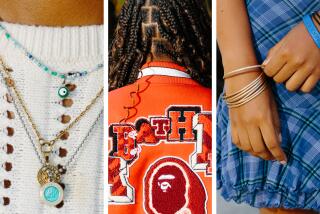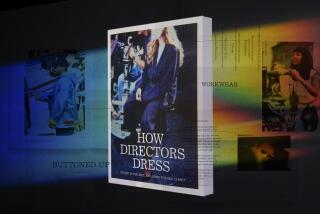Recession Puts Damper on Clothes for Business World : Designers, retailers take cautious approach, but some think youthful White House presence will brighten offerings. : 1993 A LOOK AHEAD: Wheel of Fashion Spins Toward a Youthful Look
- Share via
What do the fashion experts deem appropriate for the office in 1993?
The recovering but still sluggish economy has many designers and retailers sharing the caution of consumers, especially in recession-troubled California, where many executives are adopting the more conservative uniforms of their counterparts on that other coast.
“Fashion is merely a barometer of our economy,” said Darrell Done, merchandise director for I:xiz, a menswear chain with operations in California, Arizona and Texas. “So, as the economy becomes a little more tight, fashion pulls back.”
Regardless of the economy, however, the wheel of fashion cannot be stopped. Slowed maybe, but the new year always brings trends. And several optimistic fashion experts foresee a bright future, given the more youthful presence soon to be in the White House. That, they say, will certainly be reflected in the details--button placement, skirt lengths--and modern fabrics seen in the workplace.
The biggest news for menswear is the resurgence of the three-button suit.
“We’re now returning to a very classic look,” Done said. “So designers are trying to reintroduce a new version of the classic three-button jacket, interpreted a bit differently so it doesn’t look like an old suit.”
The body has been modified for a better fit. “Men have gotten very used to comfort and won’t go for restricting suits,” he said.
Shoulders have been narrowed some and made more natural-looking, and lapels have come in slightly. Those silhouette changes will bring buttons higher, in contrast to button placement during the past several years that neared the belt line. Much of the change comes as a response to the long-gone flashy ‘80s, which saw suits with linebacker-sized shoulders and wide lapels.
*
“What manufacturers and designers are doing is reacting to a very cautious consumer who doesn’t want to buy a fad,” Done said. “People want to invest in clothing to augment their wardrobe, not replace it. So they’re returning to a more classic approach that’s been updated with details or with more modern fabrics.”
Indeed, the only change that Steve Miller, general manager at the “very, very traditional” Burberrys in Santa Ana, sees for the new year is that the Southern California market is “switching to more traditional modes of clothing.” That includes adopting the longtime custom on the East Coast and in Europe of black for chief executives and navy for upper management.
With that conservative approach now in vogue, look for a palette of neutrals that includes the deepest navy and steel hues and some darker olive tones.
But the executive who still wants a little fun in his wardrobe can look to springtime for an explosion of color--reds, purples and greens. Muted versions of those brights in plaids and checks could be perfect for those corporate but creative jobs.
And what about the power tie, which seems to direct wardrobes every season with a new, all-important color?
“A man’s personality can be really magnified by the choice of neckwear, but power comes from the person wearing the tie--not the tie,” I:xiz’s Done said.
Still, ties can make a statement of individuality, so Dianna Pfaff-Martin of California Image Advisors suggests also making a strong business point with neckwear.
“Always carry an extra tie in your briefcase, especially if you’re the type to wear trendy ties,” said the consultant, founder of the Newport Beach company, which calls itself a “personal public relations service.”
“Changing accessories can set the mood of a garment and business meeting,” Pfaff-Martin advised both male and female executives.
*
The strong influence of the classics means that the bold cravat patterns of past year have become more subdued. The regimental rep stripe is making a comeback, sparked by the recent election (Presidents always wear rep ties), but look for wider bars.
Stripes will also appear on shirts. But Pfaff-Martin warns that combining stripes and patterns requires caution.
“A major faux pas I see is a chalk-stripe suit with a bold striped shirt made even worse with a polka-dot tie,” she said. “Normally when mixing patterns, you want only one to dominate. . . . Usually the quieter the patterns and the colors, the easier they are to mix and to ease into the workplace.”
Burberrys’ Miller also foresees the striped shirt with a white collar and french cuffs--a staple among European and East Coast executives--catching on in Southern California. On a less conventional note, Miller suggests point-collar white shirts for double-breasted and some three-button coats.
The vest is still hot for 1993, usually in a geometric print or in a vivid color, said Sandi Clark of Imageworks, a wardrobe consulting service in Irvine.
“It’s a piece now being borrowed more frequently by women that will become even more important in their wardrobes this season as either an alternative to the jacket or as a third completing piece to the suit,” she said. Choices include long or
short styles that are fitted or loose.
One element that women won’t be taking from men’s closets this year, however, is the severe menswear tailoring that dominated collections through the late ‘80s and finally peaked last year. Instead, silhouettes will become softer and fabrics more fluid--so toss out those shoulder pads.
Silk is the biggest fabric on the current scene for career wear, said Pamela Reynolds, a buyer for Orange County Nordstrom stores. It is available in heavier weights such as crepe and also appears in a silk and wool blend. Also, she said, expect to see printed silks influenced by ethnic patterns and vintage florals.
That gentler approach to career wear, experts say, comes as women gain a greater presence in the work force and become more confident of their roles, shedding the need to adopt a masculine uniform to prove themselves.
That confidence is further conveyed in the variety of colors and looks now available: nile green and brown neutrals for ethnic and safari; military detailing in red, white, blue and brass; and 1930s feminine, sophisticated suiting.
The “retro” influence, with its long, slender silhouette, is also likely to dominate professional wardrobes. To achieve that look, Reynolds said, designers are pairing longer skirts with jackets that either hit the waist or stretch to mid-thigh.
But Clark advises that not all long skirts are suitable for the office, nor is everyone able to wear them without looking as if they are dressed for a cocktail party. “Make sure it doesn’t look too sexy,” she advised. “In the corporate world that can be the kiss of death.”
She suggests playing it safe with the other fashionable length for 1993: a skirt just above the knee. Paired with a long jacket, fitted or belted, it can give that long, lean effect.
A solution for many women to the question of skirt length is the pantsuit, an item that is becoming increasingly popular, store buyers say. And designers are responding, looking to the 1930s for inspiration and coming up with an elephant-leg cut that is full at the bottom, tailored at the top.
Whatever the fashion today or tomorrow, Pfaff-Martin reminds all executives that “the details that really count are confidence, charisma and commitment to excellence.”
Those, she says, “are truly the elements of style.”






